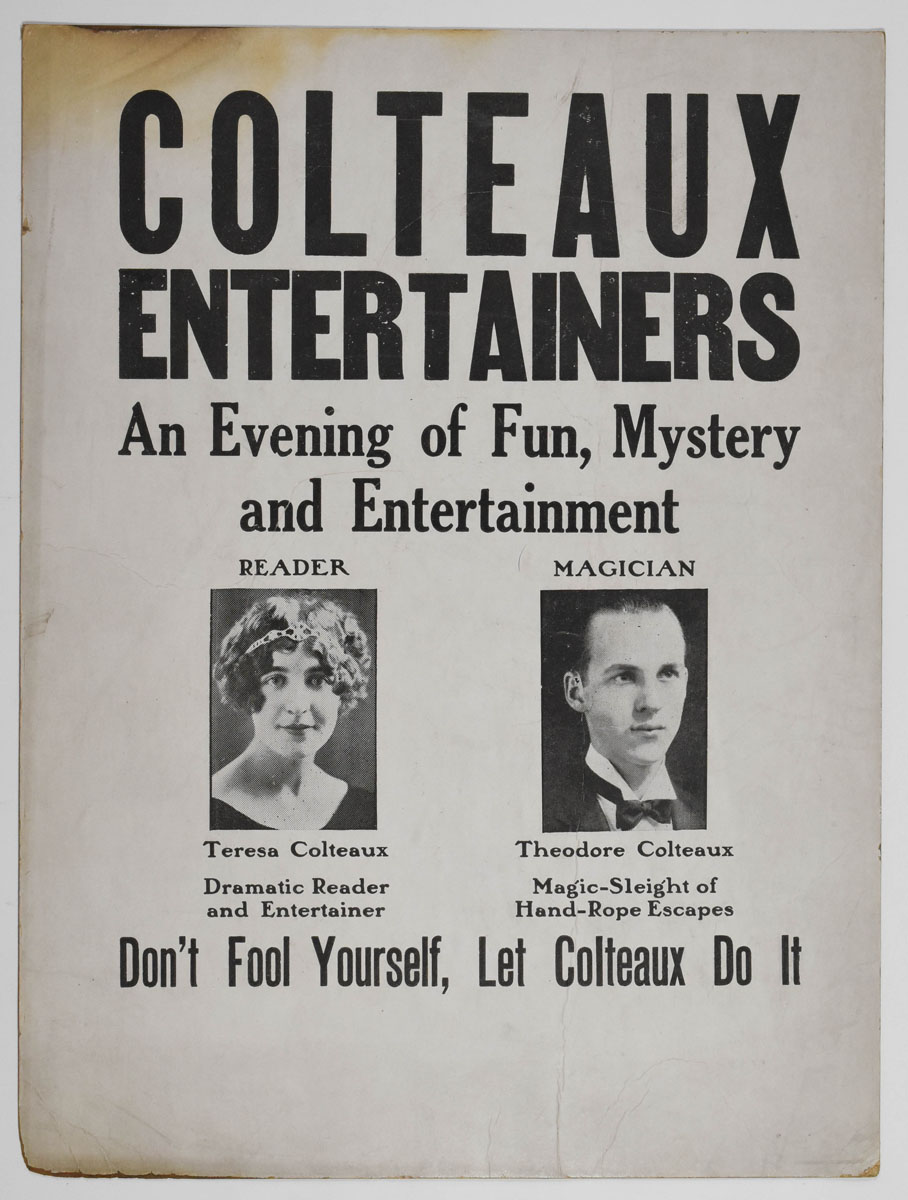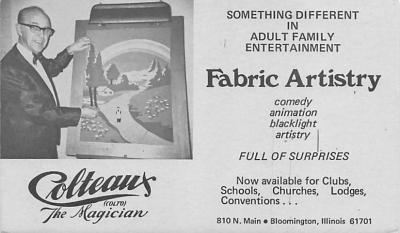The subject of this post is one George Frederick Schulte, a magician and author who created more humorous patter and one-liners than anyone of his time. This was long before Robert Orbin started turning out patter books. Schulte was born May 22, 1887 in Athens, Wisconsin. He lived there until 1899 when he moved to Chicago, which became his permanent home.
So popular a performer in the Windy City, Schulte was billed as, "Chicago's Most Popular Magician." His first appearance in the city came in 1900. Our subject had a very nice scaling card featuring his photo on the front, his name printed in red at an angle with "The Magician" printed beneath. It had the Deland back in blue.
In 1912, Schulte was presenting a Vaudeville magic act called "Magic As You Like It." I learned this when searching through my photo files and I came upon what I assumed was a postcard of the performer. Turning it over, however, I discovered it was actually part of an image from a larger photo that someone cut down. You can just see the edge of a table in the lower right and one must wonder what he was gesturing at. This was Schulte in his prime.
He was best known for his series of soft cover booklets of humorous patter and one-liners. He published "Talks for Tricks" (1916); "Magical Monologues," (1919); "Patter Paragraphs," (1921); and "Words for Wizards," (1924). These booklets are prized by collectors. According to Magicpedia, his favorite trick was the Conradi Coffee and Milk effect which was published in Dorny's book Trix and Chatter.
An auctioned "Words for Wizards" autographed by Schulte
Speaking of collecting, Schulte gathered an impressive amount of material including letters and scrapbooks and photos, many of which were stamped, "Schulte Collection." A number of these items went up for auction in recent years including on Haversat & Ewing Galleries, Potter & Potter, Swann Galleries, and the Christian Fechner auction. One auction included a letter from Houdini to Schulte thanking him for sending his most recent publication.
Another letter came from Harlan Tarbell who provided Schulte with a complimentary copy of his Tarbell Course with the admonition not to let anyone know he'd done so or he would be overwhelmed with requests.
Schulte also sold collectible magic at a time when magic collecting was barely in its infancy. He ran an ad in the May 1928 Linking Ring adverting "Old Programs" for sale. The dozen he offered included Thurston, Houdini, Blackstone, The Great Leon, Dunninger, Thorn and others. A buyer that month could have bought them all for $3.75. Sold today, these programs would be worth thousands of dollars. He even offered copies of old time magic dealer catalogs very cheaply.
Sphinx ad from 1928.
Noted historian Henry Ridgely Evans once wrote to Schulte complaining about the lack of interest in magic history. His letter noted that he (Evans) should probably just publish all of the articles that he contributed to The Sphinx in the form of a book, which he did some years later.
He contributed funny lines and quirky patter to The Sphinx for decades, always under amusing titles like, "Funology ala Magic," "Patter from Merryland," "Magicalities," and many others. These short columns featured insightful philosphies on magic and theater as well as self-effacing comments on magic enthusiasts, many who billed themselves as "Great" but rarely were.
In the fall of 1926, he was featured on the cover of The Linking Ring, and earlier in June 1917, on the cover of The Magic World, published in Philadelphia. He also appeared on the cover of The Osirian in June 1925.
In 1910 in Chicago, The World's Master Magicians was formed and met in the showrooms of Halton, Janson & LeRoy. The club had about 25 members at best but most were very famous magicians. Members included: Laurant, Roterberg, Christianer, Ralph Read, Lockman, Gilbert, Tarbell and others. The onslaught of World War I caused the club to disband around 1915. It eventually became The Chicago Magician's Club.
During World War I, Schulte performed with the famous touring entertainment troupe, the U.S. Navy "Jacks of All Trades." He also performed for troupes during World War II as well. Schulte died March 15, 1967, age 79 and was buried in Port Hudson Cemetery in East Baton Rouge Parish, Louisiana.































 f
f


















